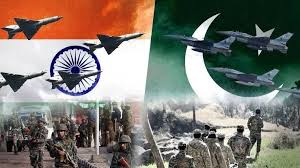The relationship between India and Pakistan is among the most complex and volatile in the world. Since their partition in 1947, the two countries have experienced wars, ceasefires, peace talks, and ongoing tensions that continue to shape South Asia’s political landscape. This article explores the latest news and updates, covering political developments, conflicts, social impact, and future prospects.
1. Historical Context: Roots of India-Pakistan Relations
The partition of British India into India and Pakistan in 1947 marked the beginning of a deep-seated rivalry. The creation of Pakistan as a separate Muslim state led to mass migrations and communal violence. One of the most contentious issues that arose was the princely state of Jammu and Kashmir, which became a flashpoint for multiple wars and ongoing disputes.
Over the decades, the two nations fought three full-scale wars (1947-48, 1965, 1971) and several smaller conflicts, including the Kargil War of 1999. Despite intermittent peace efforts, relations have often been marred by distrust and hostility.
2. Recent Political Developments
2.1 Diplomacy and Talks
Efforts to revive diplomatic relations have had mixed results. High-profile talks, confidence-building measures, and backchannel diplomacy sometimes lead to optimism, but progress is often derailed by terrorist incidents or political disagreements.
In 2025, there were attempts by both governments to reduce tensions, especially after the Pahalgam terror attack and subsequent Indian military actions. Though direct talks were limited, backchannel communications helped de-escalate the situation, leading to a ceasefire.
2.2 Internal Politics
Both countries’ domestic politics significantly influence their foreign policy. Nationalist sentiments, election campaigns, and media narratives often harden public opinion, making compromise difficult. For example, in India, political parties emphasize a tough stance on Pakistan, especially regarding terrorism and Kashmir. Similarly, Pakistan faces internal pressures from military and political groups regarding Kashmir and India’s policies.
3. Military and Security News
3.1 Border Conflicts and Ceasefires
The Line of Control (LoC) in Kashmir remains a hotbed of conflict. Frequent ceasefire violations, shelling, and infiltration attempts keep military tensions alive. In 2025, several skirmishes were reported, with casualties on both sides.
The 2025 Pahalgam terror attack, which killed 26 civilians, was a significant escalation, leading India to launch Operation Sindoor — targeted missile strikes on alleged militant camps in Pakistan-administered Kashmir.
3.2 Nuclear Deterrence and Defense Postures
Both India and Pakistan are nuclear-armed states, which adds a layer of complexity to their conflicts. While nuclear weapons act as a deterrent against full-scale war, they also create international concern about escalation risks.
Both countries continue to modernize their militaries, with India investing in advanced missile systems, fighter jets, and naval assets, and Pakistan focusing on missile and nuclear capabilities.
4. Terrorism and Counterterrorism Efforts
Terrorism remains a major sticking point in India-Pakistan relations. India accuses Pakistan’s intelligence agencies of supporting militant groups operating in Kashmir and elsewhere, charges Pakistan denies.
Internationally, there is pressure on Pakistan to crack down on terrorist organizations. Pakistan, on its part, claims to combat terrorism within its borders and blames India for internal unrest in its own provinces.
The situation remains fluid, with periodic terror attacks impacting civilian populations and escalating diplomatic tensions.
5. Economic and Social Impact
5.1 Trade and Travel
India and Pakistan have had restricted trade relations for decades. While some trade routes and cross-border travel (such as the Kartarpur Corridor for Sikh pilgrims) exist, political tensions often result in suspensions or restrictions.
Any military flare-up typically leads to border closures and travel bans, affecting families, businesses, and tourism.
5.2 Media and Public Perception
Media in both countries play a significant role in shaping public opinion. Nationalistic narratives, sensational reporting, and social media amplify tensions but also offer platforms for dialogue and people-to-people exchanges.
Despite government policies, many citizens on both sides share cultural and familial ties, and there are ongoing efforts by civil society to promote peace and understanding.
6. Sports Diplomacy: Cricket and Beyond
Cricket matches between India and Pakistan often carry huge political and emotional significance. While not a solution to conflicts, sporting encounters have sometimes eased tensions and fostered goodwill.
However, political tensions frequently result in the cancellation of scheduled matches or tournaments, reflecting the fragile nature of their relationship.
7. International Involvement and Regional Implications
Global powers, including the United States, China, Russia, and the United Nations, monitor and sometimes mediate the India-Pakistan conflict due to its potential impact on regional and global security.
China’s role is especially significant, as it borders both countries and has close ties with Pakistan. The stability of South Asia influences global trade, security alliances, and diplomatic relations.
8. Looking Forward: Challenges and Prospects
Despite repeated cycles of conflict and diplomacy, a lasting resolution remains elusive. Key challenges include:
- The Kashmir dispute and related sovereignty claims.
- Terrorism and cross-border militancy.
- Political will and public opinion in both countries.
- Regional and international diplomatic pressures.
Prospects for peace depend on sustained dialogue, confidence-building measures, and addressing underlying grievances on both sides.
Conclusion
The India-Pakistan relationship is marked by deep historical wounds and ongoing disputes. News from this region reflects a complex mix of conflict, cautious diplomacy, cultural exchange, and aspirations for peace. Understanding the full picture requires recognizing the historical context, current developments, and the human impact on millions of people living in both countries.
